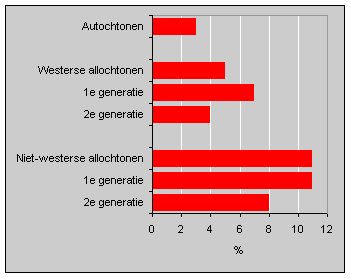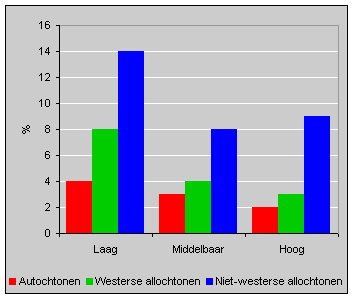More immigrants than nationals unemployed in 2000

In 2000 unemployment among non-western immigrants was three times that among the native Dutch population.. Second generation immigrants are less often unemployed than the first generation, but still much more often than native Dutch people. The differences in unemployment rates between the immigrants and the native population are encountered across all levels of education.
Non-western immigrants three times as likely to be unemployed
Immigrants are more often unemployed than native Dutch people. For the native population three percent of the labour force were unemployed, for western immigrants this rate was 5%, while for non-western immigrants it was 11%. This makes this population group three times as likely to be unemployed ad native Dutch people.

Differences between second and first generation immigrants
Unemployment rates are lower for immigrants born in the Netherlands, the second generation, than for their parents. In 2000 8% of second generation immigrants were unemployed, compared with 11% of the first generation. A similar difference can be observed for western immigrants: 4% for the second generation, 7% for the first generation. For both western immigrants and non-western immigrants unemployment rates were higher in 2000 than for the native population.

Unemployment also higher among higher educated immigrants
The differences in unemployment between immigrants and native Dutch people are present for every level of education. Lower, intermediate and higher educated immigrants are more often unemployed than the native population with the same educational level. In 2000, 14% of non-western immigrants with lower educational levels were unemployed, compared with 4% of the native population. For the highest education categories, there is also a considerable difference: 9% of higher educated non-western immigrants do not have a job, compared with only 2% of the native population.
Johan van der Valk